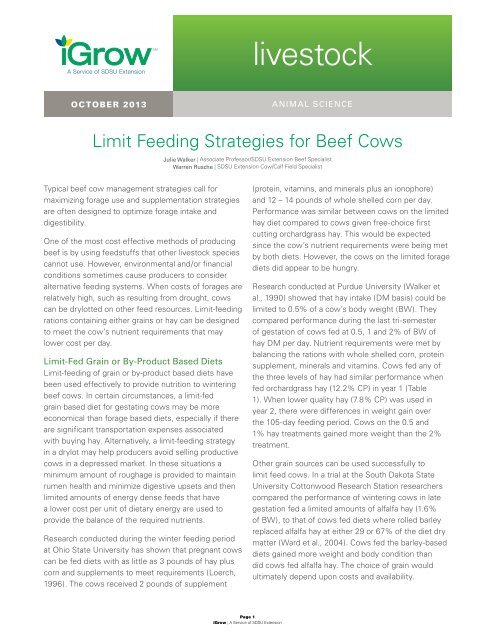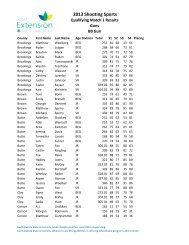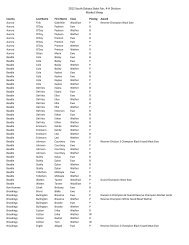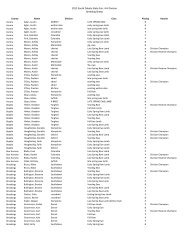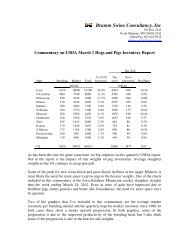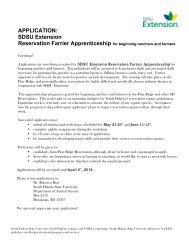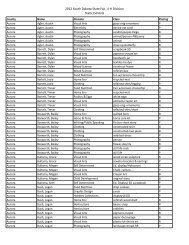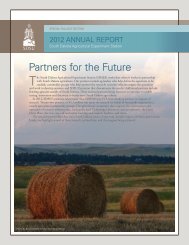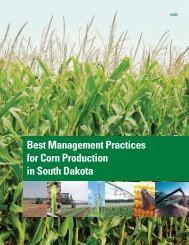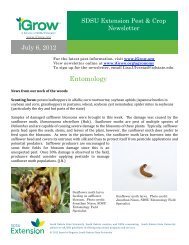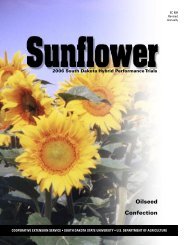Limit Feeding Strategies for Beef Cows (940 KB) Download - iGrow
Limit Feeding Strategies for Beef Cows (940 KB) Download - iGrow
Limit Feeding Strategies for Beef Cows (940 KB) Download - iGrow
You also want an ePaper? Increase the reach of your titles
YUMPU automatically turns print PDFs into web optimized ePapers that Google loves.
livestock<br />
October 2013<br />
animal science<br />
<strong>Limit</strong> <strong>Feeding</strong> <strong>Strategies</strong> <strong>for</strong> <strong>Beef</strong> <strong>Cows</strong><br />
Julie Walker | Associate Professor/SDSU Extension <strong>Beef</strong> Specialist<br />
Warren Rusche | SDSU Extension Cow/Calf Field Specialist<br />
Typical beef cow management strategies call <strong>for</strong><br />
maximizing <strong>for</strong>age use and supplementation strategies<br />
are often designed to optimize <strong>for</strong>age intake and<br />
digestibility.<br />
One of the most cost effective methods of producing<br />
beef is by using feedstuffs that other livestock species<br />
cannot use. However, environmental and/or financial<br />
conditions sometimes cause producers to consider<br />
alternative feeding systems. When costs of <strong>for</strong>ages are<br />
relatively high, such as resulting from drought, cows<br />
can be drylotted on other feed resources. <strong>Limit</strong>-feeding<br />
rations containing either grains or hay can be designed<br />
to meet the cow’s nutrient requirements that may<br />
lower cost per day.<br />
<strong>Limit</strong>-Fed Grain or By-Product Based Diets<br />
<strong>Limit</strong>-feeding of grain or by-product based diets have<br />
been used effectively to provide nutrition to wintering<br />
beef cows. In certain circumstances, a limit-fed<br />
grain based diet <strong>for</strong> gestating cows may be more<br />
economical than <strong>for</strong>age based diets, especially if there<br />
are significant transportation expenses associated<br />
with buying hay. Alternatively, a limit-feeding strategy<br />
in a drylot may help producers avoid selling productive<br />
cows in a depressed market. In these situations a<br />
minimum amount of roughage is provided to maintain<br />
rumen health and minimize digestive upsets and then<br />
limited amounts of energy dense feeds that have<br />
a lower cost per unit of dietary energy are used to<br />
provide the balance of the required nutrients.<br />
Research conducted during the winter feeding period<br />
at Ohio State University has shown that pregnant cows<br />
can be fed diets with as little as 3 pounds of hay plus<br />
corn and supplements to meet requirements (Loerch,<br />
1996). The cows received 2 pounds of supplement<br />
(protein, vitamins, and minerals plus an ionophore)<br />
and 12 – 14 pounds of whole shelled corn per day.<br />
Per<strong>for</strong>mance was similar between cows on the limited<br />
hay diet compared to cows given free-choice first<br />
cutting orchardgrass hay. This would be expected<br />
since the cow’s nutrient requirements were being met<br />
by both diets. However, the cows on the limited <strong>for</strong>age<br />
diets did appear to be hungry.<br />
Research conducted at Purdue University (Walker et<br />
al., 1990) showed that hay intake (DM basis) could be<br />
limited to 0.5% of a cow’s body weight (BW). They<br />
compared per<strong>for</strong>mance during the last tri-semester<br />
of gestation of cows fed at 0.5, 1 and 2% of BW of<br />
hay DM per day. Nutrient requirements were met by<br />
balancing the rations with whole shelled corn, protein<br />
supplement, minerals and vitamins. <strong>Cows</strong> fed any of<br />
the three levels of hay had similar per<strong>for</strong>mance when<br />
fed orchardgrass hay (12.2% CP) in year 1 (Table<br />
1). When lower quality hay (7.8% CP) was used in<br />
year 2, there were differences in weight gain over<br />
the 105-day feeding period. <strong>Cows</strong> on the 0.5 and<br />
1% hay treatments gained more weight than the 2%<br />
treatment.<br />
Other grain sources can be used successfully to<br />
limit feed cows. In a trial at the South Dakota State<br />
University Cottonwood Research Station researchers<br />
compared the per<strong>for</strong>mance of wintering cows in late<br />
gestation fed a limited amounts of alfalfa hay (1.6%<br />
of BW), to that of cows fed diets where rolled barley<br />
replaced alfalfa hay at either 29 or 67% of the diet dry<br />
matter (Ward et al., 2004). <strong>Cows</strong> fed the barley-based<br />
diets gained more weight and body condition than<br />
did cows fed alfalfa hay. The choice of grain would<br />
ultimately depend upon costs and availability.<br />
Page 1<br />
<strong>iGrow</strong> | A Service of SDSU Extension
livestock<br />
Table 1. Alternative hay strategies on cow per<strong>for</strong>mance<br />
Treatments<br />
Item<br />
2% Hay 1% Hay 0.5% Hay<br />
Year 1<br />
Initial Wt, lbs 1279 1274 1260<br />
Initial BCS 5.2 5.1 4.9<br />
Wt. change, lbs 96 110 83<br />
BCS change -.13 -.14 -.06<br />
Year 2<br />
Initial Wt, lbs 1281 1271 1279<br />
Initial BCS 4.7 4.7 4.7<br />
Wt change, lbs 56 102 111<br />
BCS change -.14 0 -.20<br />
BCS = body condition score; (9 point scale, 1 = emaciated to 9 = obese)<br />
(Walker et al., 1990)<br />
By-products of grain processing can also be utilized<br />
as substitutes <strong>for</strong> hay. These feeds can be especially<br />
useful in beef cow diets because of higher levels of<br />
digestible fiber and reduced starch content compared<br />
to grains. Using highly digestible fiber sources such as<br />
soybean hulls, wheat middlings, or distillers grains can<br />
help avoid potential digestive problems associated with<br />
feeding grain (starch) based diets while maintaining<br />
energy intake.<br />
In a study conducted at the Ohio State University,<br />
gestating beef cows were fed diets based on hay<br />
or limited amounts of shelled corn or dried distillers<br />
grains (DDGS) such that all diets met or exceeded<br />
NRC cow requirements (Radunz et al., 2010). <strong>Cows</strong><br />
fed DDGS gained more weight during gestation, but<br />
there were no differences in subsequent reproductive<br />
per<strong>for</strong>mance. <strong>Cows</strong> that were limit fed either corn or<br />
DDGS did have calves with increased birth weights,<br />
but there were no differences in the incidence of<br />
calving difficulty.<br />
When utilizing by-product feeds, particularly ethanol<br />
by-products, it is important to make sure that nutrients,<br />
such as sulfur and fat, do not exceed maximum<br />
recommended levels. Dietary sulfur should not exceed<br />
0.3% <strong>for</strong> cattle consuming diets containing 85% or<br />
more concentrate and 0.5% <strong>for</strong> cattle consuming at<br />
least 40% <strong>for</strong>age (all on a DM basis) and fat content<br />
should not be over 5 to 6% of the diet on a dry basis.<br />
These restrictions limit the amount of certain byproducts<br />
that can be fed to cattle, especially distiller’s<br />
grains. Nutrient composition of distillers grains varies<br />
depending upon the procedures at a particular ethanol<br />
plant, so it is important to utilize recent feed analyses<br />
when determining how much distillers can be included<br />
in a ration. It’s also important to consider the sulfate<br />
content of the water source when determining the<br />
amount of by-product feeds that can safely be fed.<br />
The variability of some by-product feeds can cause<br />
unacceptable per<strong>for</strong>mance if that variability is not<br />
managed and the cattle’s per<strong>for</strong>mance not monitored.<br />
Researchers at the Carrington Research Extension<br />
Center (ND) noted that cows fed sunflower screenings<br />
lost a significant amount of weight and body condition,<br />
resulting in decreased conception rate (Anderson,<br />
2002). This was attributed to changing nutrient<br />
composition of the screenings over time, an issue that<br />
can make balancing a diet difficult.<br />
Changing from a <strong>for</strong>age-based diet to one containing<br />
a greater proportion of grains or by-product feeds also<br />
may change mineral supplementation needs. Many of<br />
these feeds contain relatively high levels of phosphorus<br />
and lower levels of calcium compared to typical<br />
<strong>for</strong>ages. Because of those differences supplemental<br />
phosphorus needs can be reduced or even eliminated;<br />
however, supplemental calcium may need to be added.<br />
As long as dietary requirements have been met, the<br />
calcium:phosphorus ratio can range from 1.5:1 to 7:1<br />
without causing metabolic disorders.<br />
<strong>Limit</strong>ing Access to Hay<br />
<strong>Limit</strong>ing the amount of time cows have access to<br />
hay is another method of reducing <strong>for</strong>age usage.<br />
Dr. Ron Lemenager at Purdue University conducted<br />
experiments over a three year period to study how<br />
much hay was consumed when cows were given<br />
only a limited amount of time to eat. Forage intake<br />
was reduced by as much as 75%, 60%, and 33%,<br />
respectively, when cattle were restricted to 1, 2, or<br />
3 hours access to hay compared to cows having free<br />
access to hay. Soybean hull pellets were used to meet<br />
the balance of the cows’ nutrient requirements (R.<br />
Lemenager, personal correspondence).<br />
In order to successfully implement this strategy,<br />
the amount of <strong>for</strong>age consumed must be accurately<br />
estimated so that the diet can be supplemented<br />
correctly to maintain acceptable cow per<strong>for</strong>mance. To<br />
determine the relationship between hay quality and<br />
Page 2<br />
<strong>iGrow</strong> | A Service of SDSU Extension
livestock<br />
hay intake under free-choice and restricted conditions,<br />
researchers at Purdue University compared the amount<br />
of hay consumed when cows were allowed 1, 2, 4, or<br />
24 hr/d access to low, medium, or high quality grass<br />
hay during late gestation (Lemenager and Johnson,<br />
2012).<br />
As shown in Table 2, <strong>for</strong>age intake increased as<br />
hay quality improved regardless of the access time<br />
allowed. Restricting access decreased the amount of<br />
hay consumed. The reductions in hay intake due to<br />
access restrictions were similar <strong>for</strong> the low, medium,<br />
and high quality roughages.<br />
Table 2. Hay intake by access time and amount of soybean<br />
hull supplementation.<br />
Access Time (hr/d)<br />
1 hr 2 hr 4 hr Ad lib<br />
Low Quality Grass Hay Diet – Late Gestation<br />
Hay consumption as-fed, lb 8.2 14.5 23.8 29.0<br />
Soybean Hulls, lb 13.2 10.5 6.7 4.6<br />
Mixed Hay Diet – Late Gestation<br />
Hay consumption as-fed, lb 9.8 16.8 25.0 32.0<br />
Soybean Hulls, lb 11.3 7. 5 3.1 0.0<br />
High Quality Grass Hay Diet – Late Gestation<br />
Hay consumption as-fed, lb 10.4 17. 1 27.5 35.0<br />
Soybean Hulls, lb 10.7 6.9 1.0 0.0<br />
Animals were 1250 lb. cows, gaining .25 lb/d in late gestation<br />
(8 months pregnant)<br />
Low quality hay = 47.3% TDN, 8.1% CP<br />
Mixed hay = 54.0% TDN, 12.5% CP<br />
High quality hay = 56.7% TDN, 17.1% CP<br />
Soyhulls = 80% TDN, 12.2% CP (NRC 1996)<br />
(R. Lemenager, personal correspondence)<br />
Using these results, the researchers at Purdue<br />
University developed the following equations to<br />
estimate ad lib and time restricted hay intake. Ad lib dry<br />
matter intake of <strong>for</strong>age per head per day <strong>for</strong> cattle can<br />
be estimated from the calculation:<br />
120 divided by NDF % (Neutral Detergent Fiber;<br />
DM basis) = Hay Dry Matter Intake (expressed as<br />
% cow body weight)<br />
The following equation estimates <strong>for</strong>age intake based<br />
on NDF content and length of hay access time.<br />
0.3 x hours of access/day – (0.02 x (Hay DM<br />
NDF % x 100)) + 1.34 = Hay Dry Matter Intake<br />
(expressed as % cow body weight) where the NDF<br />
% is expressed as a decimal.<br />
Example: 4 hours of hay access; 53% NDF on DM<br />
basis; 1300-pound cow<br />
0.3 x 4 hours – (0.02 x (0.53 x 100)) + 1.34 = DM<br />
Intake of Hay (% of bodyweight)<br />
1.2 – (0.02 x 53) + 1.34 = 1.2 – 1.06 + 1.34 =<br />
1.48% of body weight as dry matter hay intake<br />
when limited to 4 hours<br />
Estimated ad lib intake of this hay: 120 ÷ (0.53 x 100)<br />
= 2.26% of bodyweight<br />
1300 lbs. cow x 1.48% = 19.2 lbs. of DM Hay per<br />
day when limited to 4 hours<br />
1300 lbs. cow x 2.26% = 29.4 lbs. of DM Hay per<br />
day ad lib intake<br />
In this example the amount of hay consumed per day<br />
would be reduced by 10.2 lb. per day on a dry basis<br />
(34% reduction). Assuming that the feeding period<br />
was 120 days long and that the hay was 88% dry<br />
matter, this system would result in a feed savings of<br />
1390 pounds per cow.<br />
The amount of space provided and the design of the<br />
hay feeders also may play a role in the amount of hay<br />
that is wasted and there<strong>for</strong>e the amount of hay that<br />
must be provided each day. Buskirk et al., (2003) at<br />
Michigan State observed that cows fed with cone-type<br />
hay feeders wasted the least amount of hay (3.5%)<br />
compared to 6.1, 11.4 and 14.6% <strong>for</strong> ring, trailer and<br />
cradle feeders, respectively. Regardless of feeder<br />
design, there should be enough room available so that<br />
all cows can access the hay at the same time.<br />
Management Factors<br />
<strong>Limit</strong> feeding cows does represent a significant<br />
departure from more conventional management<br />
practices. There are some management factors that<br />
should be considered to successfully implement these<br />
strategies. These include:<br />
1. All feedstuffs should be tested <strong>for</strong> nutrient<br />
composition and nitrate levels, if appropriate. That<br />
in<strong>for</strong>mation can then be used to <strong>for</strong>mulate diets<br />
that meet the animals’ requirements at the best<br />
cost.<br />
2. Gradually step up the animals onto the energy<br />
dense feeds. One approach is to start cattle at 4<br />
pounds per head per day and then add 1 pound<br />
every other day until the desired amount of energy<br />
Page 3<br />
<strong>iGrow</strong> | A Service of SDSU Extension
livestock<br />
dense feed is reached. As the amount of energy<br />
dense feed increases, the <strong>for</strong>age portion of the diet<br />
should be gradually reduced.<br />
3. When diets containing a higher proportion of grain<br />
are fed to cows, proper bunk management to avoid<br />
digestive upsets is extremely important, especially<br />
when high-starch feedstuffs like grains are fed.<br />
Minimizing the day-to-day variation in grain intake<br />
will help reduce the incidence of acidosis and bloat.<br />
Monensin is labeled <strong>for</strong> use in mature beef cows<br />
and has been shown to help reduce the incidence<br />
of bloat and acidosis along with increasing feed<br />
efficiency.<br />
4. Implementing a limit-feeding strategy will be easier<br />
if a mixer wagon and a scale are available. It’s<br />
important to allow <strong>for</strong> sufficient mixing time so that<br />
all ingredients are distributed evenly throughout the<br />
load. If mixing equipment is not available, offering<br />
a fixed amount of a supplement combined with<br />
limiting the amount time cows have access to hay<br />
can be effective.<br />
5. Mineral and vitamin mixes may be over consumed<br />
if offered free-choice when animals are limit-fed.<br />
These could be included in the mixed ration, or<br />
consumption could be controlled using white salt.<br />
6. Adequate bunk space (30 inches per head) should<br />
be provided to allow all cattle an equal opportunity<br />
to consume the ration.<br />
7. Pens should provide at least 500 square feet<br />
per head. It may be worth considering sacrificial<br />
pasture areas as a way to provide additional room<br />
and to mitigate the effects of muddy conditions<br />
during wet and inclement weather.<br />
8. While the nutrient requirements of the cattle can<br />
be met using limit feeding strategies, their appetite<br />
will not be satisfied. Fences will need to be strong<br />
enough to withstand mature cows pushing against<br />
and reaching through in an attempt to graze plant<br />
material that may be within their reach.<br />
9. As with any feeding system, monitor body<br />
condition to determine if nutritional demands are<br />
being met. Adjust diets if needed to avoid under- or<br />
over-conditioning.<br />
Summary<br />
<strong>Limit</strong>ing <strong>for</strong>age intake can be a successful strategy<br />
to reduce feed expenses under certain conditions,<br />
or as strategy to avoid herd liquidation. The success<br />
or failure of a limit-feeding system will depend on<br />
the resources available and their cost, and the ability<br />
to provide the level of management required to<br />
implement this strategy.<br />
Literature Cited<br />
Anderson, V.L. 2002. Sunflower screenings, barley<br />
malt or wheat midds in lactating beef cow diets. <strong>Beef</strong><br />
Production Field Day Proceedings. NDSU Carrington<br />
Research Extension Center. Volume 25:33-36.<br />
Buskirk, D.D., A.J. Zanella, T.M. Harrigan, J.L. Van<br />
Lente, L.M. Gnagey, and M.J. Kaercher. 2003. Large<br />
round bale feeder design affects hay utilization and<br />
beef cow behavior. J. Anim. Sci. 81:109-115.<br />
Lemenager, R.P. and K. Johnson. 2012. <strong>Beef</strong><br />
Management Practices When Forages are in Short<br />
Supply. Available at: http://www.agry.purdue.edu/ext/<br />
<strong>for</strong>ages/<strong>Beef</strong>%20Mgmt%20Practices%20-Short%20<br />
Forage%20Supply%20July%202012.pdf.<br />
Loerch. S.C. 1996. <strong>Limit</strong>-feeding corn as an alternative<br />
to hay <strong>for</strong> gestating beef cows. J. Anim. Sci. 74:1211-<br />
1216.<br />
National Research Council. 1996. Nutrient<br />
requirements of beef cattle.<br />
Radunz, A.E., F.L Fluharty, M.L. Day, H.N. Zerby, and<br />
S.C. Loerch. 2010. Prepartum dietary energy source<br />
fed to beef cows: I. Effects on pre- and postpartum<br />
cow per<strong>for</strong>mance. J. Anim. Sci. 88:2717-2728.<br />
Walker, J.A., R.P. Lemenager, and K.S. Hendrix. 1990.<br />
Alternative feeding program when <strong>for</strong>age is limiting.<br />
Purdue University <strong>Beef</strong>/Dairy Report. p. 29.<br />
Ward, E.H., H.H. Patterson, and R.J. Pruitt. 2004.<br />
Response of gestating beef cows to limit-fed diets<br />
containing rolled barley. <strong>Beef</strong> 2004-10 pp. 51-54. SD<br />
<strong>Beef</strong> Report. South Dakota Ag Experiment Station.<br />
South Dakota State University, South Dakota counties, and USDA cooperating. South Dakota State University adheres to AA/EEO<br />
guidelines in offering educational programs and services.<br />
Publication: 02-2009-2013<br />
Page 4<br />
<strong>iGrow</strong> | A Service of SDSU Extension


